Coca-Cola's Business, Society, and Planet: A Sustainability Analysis
VerifiedAdded on 2020/03/07
|6
|1367
|33
Report
AI Summary
This report provides an analysis of Coca-Cola's sustainability practices, focusing on its environmental and social initiatives. It begins with an introduction to Coca-Cola, a multinational beverage company, and its operational structure. The report then delves into Coca-Cola's sustainability initiatives, including its "commitment 2020" program, which aims to reduce carbon footprint, recover packaging, minimize water usage, and increase recycling. The analysis covers the company's progress in reducing carbon emissions, packaging waste, and water consumption. It also examines Coca-Cola's social initiatives, such as efforts to reduce the caloric value of its products and promote health and wellness through educational programs. The report further explores specific sustainability practices across industries, including responses to consumer well-being, product diversification, and water management strategies. Group discussions are summarized, highlighting the perception of Coca-Cola as a sustainable and environment-friendly organization. The conclusion emphasizes the importance of in-depth studies to understand the company's performance in relation to its CSR initiatives and suggests that Coca-Cola fosters a better culture of CSR and sustainability practices than many other companies.
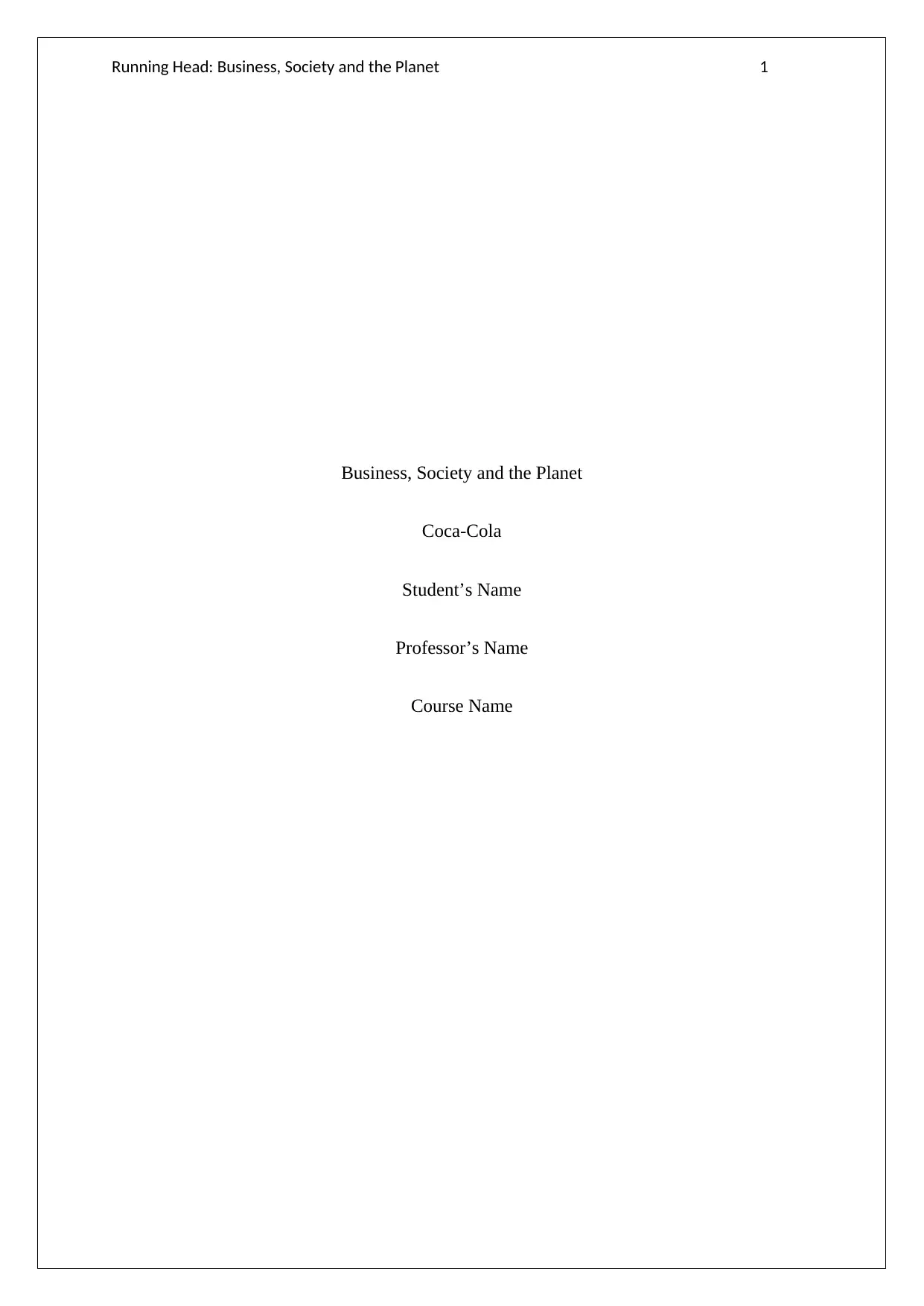
Running Head: Business, Society and the Planet 1
Business, Society and the Planet
Coca-Cola
Student’s Name
Professor’s Name
Course Name
Business, Society and the Planet
Coca-Cola
Student’s Name
Professor’s Name
Course Name
Paraphrase This Document
Need a fresh take? Get an instant paraphrase of this document with our AI Paraphraser
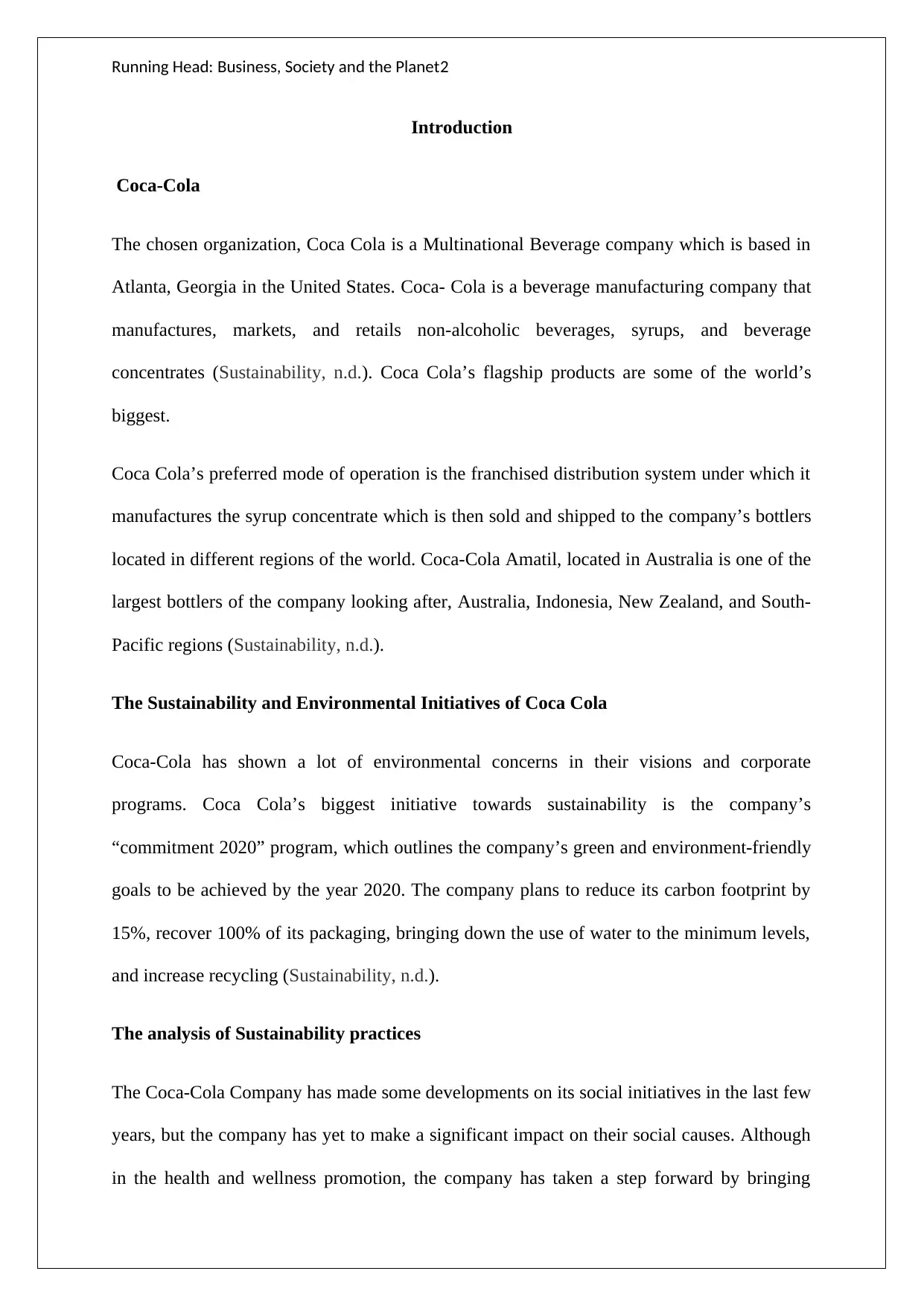
Running Head: Business, Society and the Planet2
Introduction
Coca-Cola
The chosen organization, Coca Cola is a Multinational Beverage company which is based in
Atlanta, Georgia in the United States. Coca- Cola is a beverage manufacturing company that
manufactures, markets, and retails non-alcoholic beverages, syrups, and beverage
concentrates (Sustainability, n.d.). Coca Cola’s flagship products are some of the world’s
biggest.
Coca Cola’s preferred mode of operation is the franchised distribution system under which it
manufactures the syrup concentrate which is then sold and shipped to the company’s bottlers
located in different regions of the world. Coca-Cola Amatil, located in Australia is one of the
largest bottlers of the company looking after, Australia, Indonesia, New Zealand, and South-
Pacific regions (Sustainability, n.d.).
The Sustainability and Environmental Initiatives of Coca Cola
Coca-Cola has shown a lot of environmental concerns in their visions and corporate
programs. Coca Cola’s biggest initiative towards sustainability is the company’s
“commitment 2020” program, which outlines the company’s green and environment-friendly
goals to be achieved by the year 2020. The company plans to reduce its carbon footprint by
15%, recover 100% of its packaging, bringing down the use of water to the minimum levels,
and increase recycling (Sustainability, n.d.).
The analysis of Sustainability practices
The Coca-Cola Company has made some developments on its social initiatives in the last few
years, but the company has yet to make a significant impact on their social causes. Although
in the health and wellness promotion, the company has taken a step forward by bringing
Introduction
Coca-Cola
The chosen organization, Coca Cola is a Multinational Beverage company which is based in
Atlanta, Georgia in the United States. Coca- Cola is a beverage manufacturing company that
manufactures, markets, and retails non-alcoholic beverages, syrups, and beverage
concentrates (Sustainability, n.d.). Coca Cola’s flagship products are some of the world’s
biggest.
Coca Cola’s preferred mode of operation is the franchised distribution system under which it
manufactures the syrup concentrate which is then sold and shipped to the company’s bottlers
located in different regions of the world. Coca-Cola Amatil, located in Australia is one of the
largest bottlers of the company looking after, Australia, Indonesia, New Zealand, and South-
Pacific regions (Sustainability, n.d.).
The Sustainability and Environmental Initiatives of Coca Cola
Coca-Cola has shown a lot of environmental concerns in their visions and corporate
programs. Coca Cola’s biggest initiative towards sustainability is the company’s
“commitment 2020” program, which outlines the company’s green and environment-friendly
goals to be achieved by the year 2020. The company plans to reduce its carbon footprint by
15%, recover 100% of its packaging, bringing down the use of water to the minimum levels,
and increase recycling (Sustainability, n.d.).
The analysis of Sustainability practices
The Coca-Cola Company has made some developments on its social initiatives in the last few
years, but the company has yet to make a significant impact on their social causes. Although
in the health and wellness promotion, the company has taken a step forward by bringing
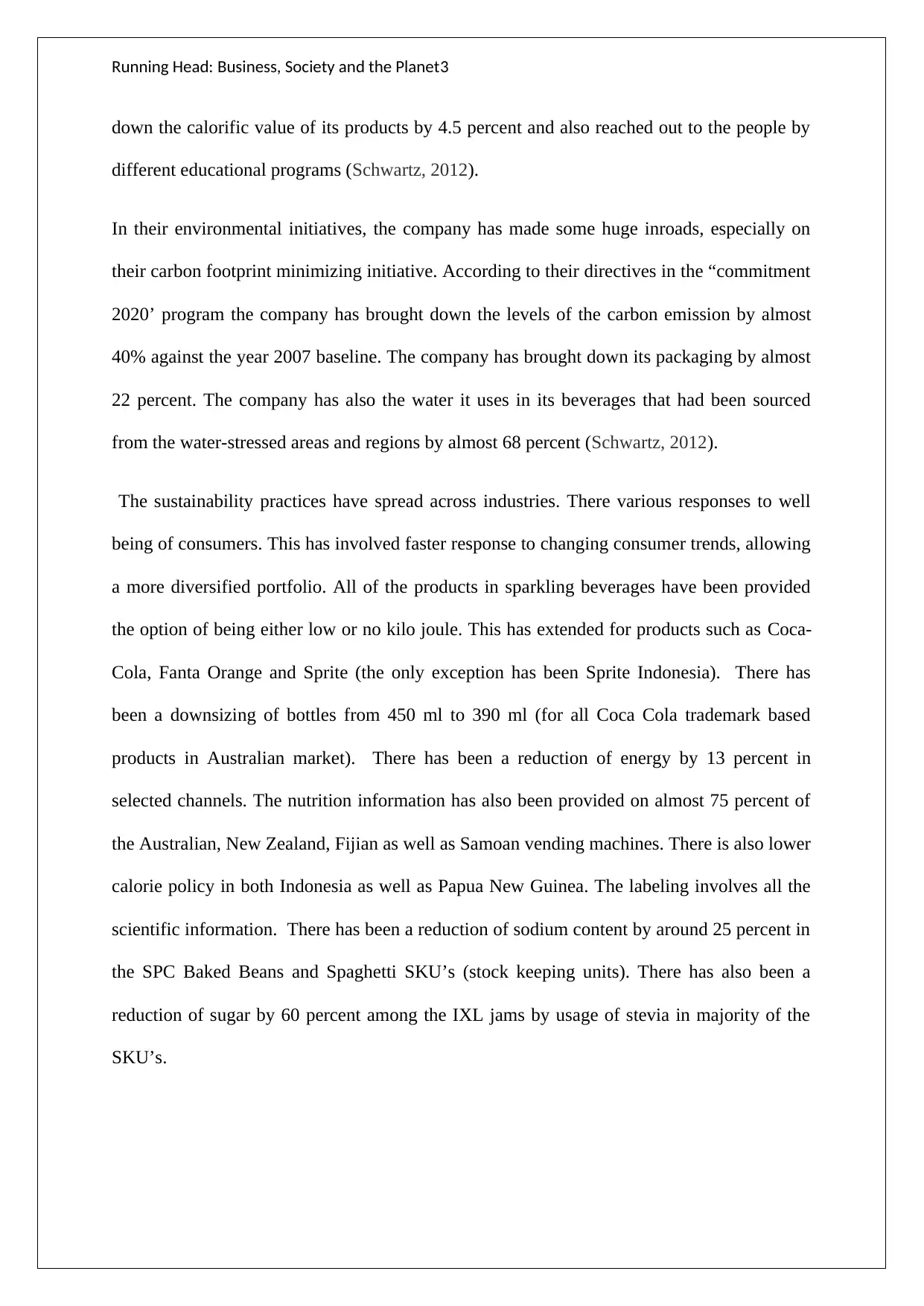
Running Head: Business, Society and the Planet3
down the calorific value of its products by 4.5 percent and also reached out to the people by
different educational programs (Schwartz, 2012).
In their environmental initiatives, the company has made some huge inroads, especially on
their carbon footprint minimizing initiative. According to their directives in the “commitment
2020’ program the company has brought down the levels of the carbon emission by almost
40% against the year 2007 baseline. The company has brought down its packaging by almost
22 percent. The company has also the water it uses in its beverages that had been sourced
from the water-stressed areas and regions by almost 68 percent (Schwartz, 2012).
The sustainability practices have spread across industries. There various responses to well
being of consumers. This has involved faster response to changing consumer trends, allowing
a more diversified portfolio. All of the products in sparkling beverages have been provided
the option of being either low or no kilo joule. This has extended for products such as Coca-
Cola, Fanta Orange and Sprite (the only exception has been Sprite Indonesia). There has
been a downsizing of bottles from 450 ml to 390 ml (for all Coca Cola trademark based
products in Australian market). There has been a reduction of energy by 13 percent in
selected channels. The nutrition information has also been provided on almost 75 percent of
the Australian, New Zealand, Fijian as well as Samoan vending machines. There is also lower
calorie policy in both Indonesia as well as Papua New Guinea. The labeling involves all the
scientific information. There has been a reduction of sodium content by around 25 percent in
the SPC Baked Beans and Spaghetti SKU’s (stock keeping units). There has also been a
reduction of sugar by 60 percent among the IXL jams by usage of stevia in majority of the
SKU’s.
down the calorific value of its products by 4.5 percent and also reached out to the people by
different educational programs (Schwartz, 2012).
In their environmental initiatives, the company has made some huge inroads, especially on
their carbon footprint minimizing initiative. According to their directives in the “commitment
2020’ program the company has brought down the levels of the carbon emission by almost
40% against the year 2007 baseline. The company has brought down its packaging by almost
22 percent. The company has also the water it uses in its beverages that had been sourced
from the water-stressed areas and regions by almost 68 percent (Schwartz, 2012).
The sustainability practices have spread across industries. There various responses to well
being of consumers. This has involved faster response to changing consumer trends, allowing
a more diversified portfolio. All of the products in sparkling beverages have been provided
the option of being either low or no kilo joule. This has extended for products such as Coca-
Cola, Fanta Orange and Sprite (the only exception has been Sprite Indonesia). There has
been a downsizing of bottles from 450 ml to 390 ml (for all Coca Cola trademark based
products in Australian market). There has been a reduction of energy by 13 percent in
selected channels. The nutrition information has also been provided on almost 75 percent of
the Australian, New Zealand, Fijian as well as Samoan vending machines. There is also lower
calorie policy in both Indonesia as well as Papua New Guinea. The labeling involves all the
scientific information. There has been a reduction of sodium content by around 25 percent in
the SPC Baked Beans and Spaghetti SKU’s (stock keeping units). There has also been a
reduction of sugar by 60 percent among the IXL jams by usage of stevia in majority of the
SKU’s.
⊘ This is a preview!⊘
Do you want full access?
Subscribe today to unlock all pages.

Trusted by 1+ million students worldwide
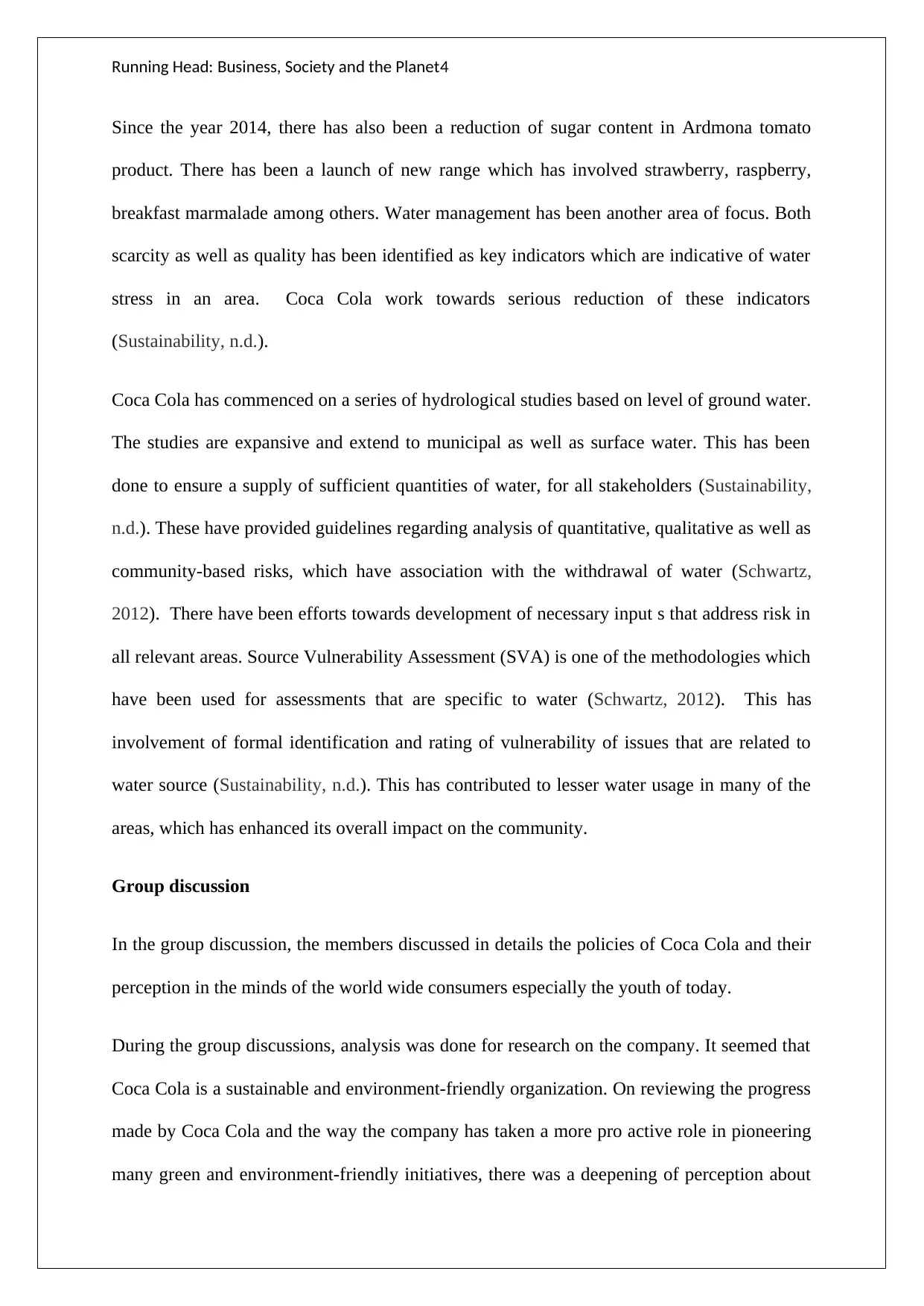
Running Head: Business, Society and the Planet4
Since the year 2014, there has also been a reduction of sugar content in Ardmona tomato
product. There has been a launch of new range which has involved strawberry, raspberry,
breakfast marmalade among others. Water management has been another area of focus. Both
scarcity as well as quality has been identified as key indicators which are indicative of water
stress in an area. Coca Cola work towards serious reduction of these indicators
(Sustainability, n.d.).
Coca Cola has commenced on a series of hydrological studies based on level of ground water.
The studies are expansive and extend to municipal as well as surface water. This has been
done to ensure a supply of sufficient quantities of water, for all stakeholders (Sustainability,
n.d.). These have provided guidelines regarding analysis of quantitative, qualitative as well as
community-based risks, which have association with the withdrawal of water (Schwartz,
2012). There have been efforts towards development of necessary input s that address risk in
all relevant areas. Source Vulnerability Assessment (SVA) is one of the methodologies which
have been used for assessments that are specific to water (Schwartz, 2012). This has
involvement of formal identification and rating of vulnerability of issues that are related to
water source (Sustainability, n.d.). This has contributed to lesser water usage in many of the
areas, which has enhanced its overall impact on the community.
Group discussion
In the group discussion, the members discussed in details the policies of Coca Cola and their
perception in the minds of the world wide consumers especially the youth of today.
During the group discussions, analysis was done for research on the company. It seemed that
Coca Cola is a sustainable and environment-friendly organization. On reviewing the progress
made by Coca Cola and the way the company has taken a more pro active role in pioneering
many green and environment-friendly initiatives, there was a deepening of perception about
Since the year 2014, there has also been a reduction of sugar content in Ardmona tomato
product. There has been a launch of new range which has involved strawberry, raspberry,
breakfast marmalade among others. Water management has been another area of focus. Both
scarcity as well as quality has been identified as key indicators which are indicative of water
stress in an area. Coca Cola work towards serious reduction of these indicators
(Sustainability, n.d.).
Coca Cola has commenced on a series of hydrological studies based on level of ground water.
The studies are expansive and extend to municipal as well as surface water. This has been
done to ensure a supply of sufficient quantities of water, for all stakeholders (Sustainability,
n.d.). These have provided guidelines regarding analysis of quantitative, qualitative as well as
community-based risks, which have association with the withdrawal of water (Schwartz,
2012). There have been efforts towards development of necessary input s that address risk in
all relevant areas. Source Vulnerability Assessment (SVA) is one of the methodologies which
have been used for assessments that are specific to water (Schwartz, 2012). This has
involvement of formal identification and rating of vulnerability of issues that are related to
water source (Sustainability, n.d.). This has contributed to lesser water usage in many of the
areas, which has enhanced its overall impact on the community.
Group discussion
In the group discussion, the members discussed in details the policies of Coca Cola and their
perception in the minds of the world wide consumers especially the youth of today.
During the group discussions, analysis was done for research on the company. It seemed that
Coca Cola is a sustainable and environment-friendly organization. On reviewing the progress
made by Coca Cola and the way the company has taken a more pro active role in pioneering
many green and environment-friendly initiatives, there was a deepening of perception about
Paraphrase This Document
Need a fresh take? Get an instant paraphrase of this document with our AI Paraphraser
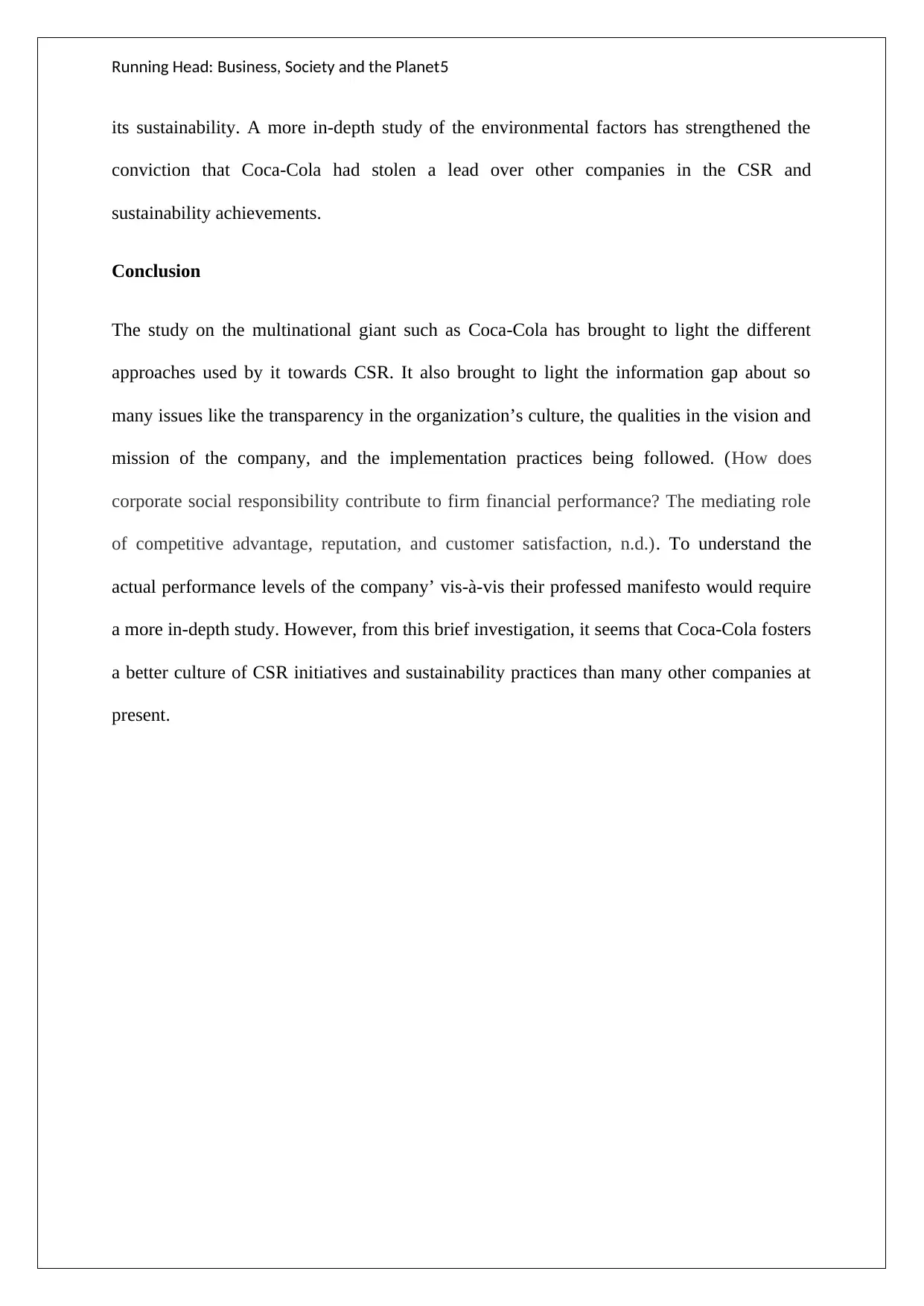
Running Head: Business, Society and the Planet5
its sustainability. A more in-depth study of the environmental factors has strengthened the
conviction that Coca-Cola had stolen a lead over other companies in the CSR and
sustainability achievements.
Conclusion
The study on the multinational giant such as Coca-Cola has brought to light the different
approaches used by it towards CSR. It also brought to light the information gap about so
many issues like the transparency in the organization’s culture, the qualities in the vision and
mission of the company, and the implementation practices being followed. (How does
corporate social responsibility contribute to firm financial performance? The mediating role
of competitive advantage, reputation, and customer satisfaction, n.d.). To understand the
actual performance levels of the company’ vis-à-vis their professed manifesto would require
a more in-depth study. However, from this brief investigation, it seems that Coca-Cola fosters
a better culture of CSR initiatives and sustainability practices than many other companies at
present.
its sustainability. A more in-depth study of the environmental factors has strengthened the
conviction that Coca-Cola had stolen a lead over other companies in the CSR and
sustainability achievements.
Conclusion
The study on the multinational giant such as Coca-Cola has brought to light the different
approaches used by it towards CSR. It also brought to light the information gap about so
many issues like the transparency in the organization’s culture, the qualities in the vision and
mission of the company, and the implementation practices being followed. (How does
corporate social responsibility contribute to firm financial performance? The mediating role
of competitive advantage, reputation, and customer satisfaction, n.d.). To understand the
actual performance levels of the company’ vis-à-vis their professed manifesto would require
a more in-depth study. However, from this brief investigation, it seems that Coca-Cola fosters
a better culture of CSR initiatives and sustainability practices than many other companies at
present.
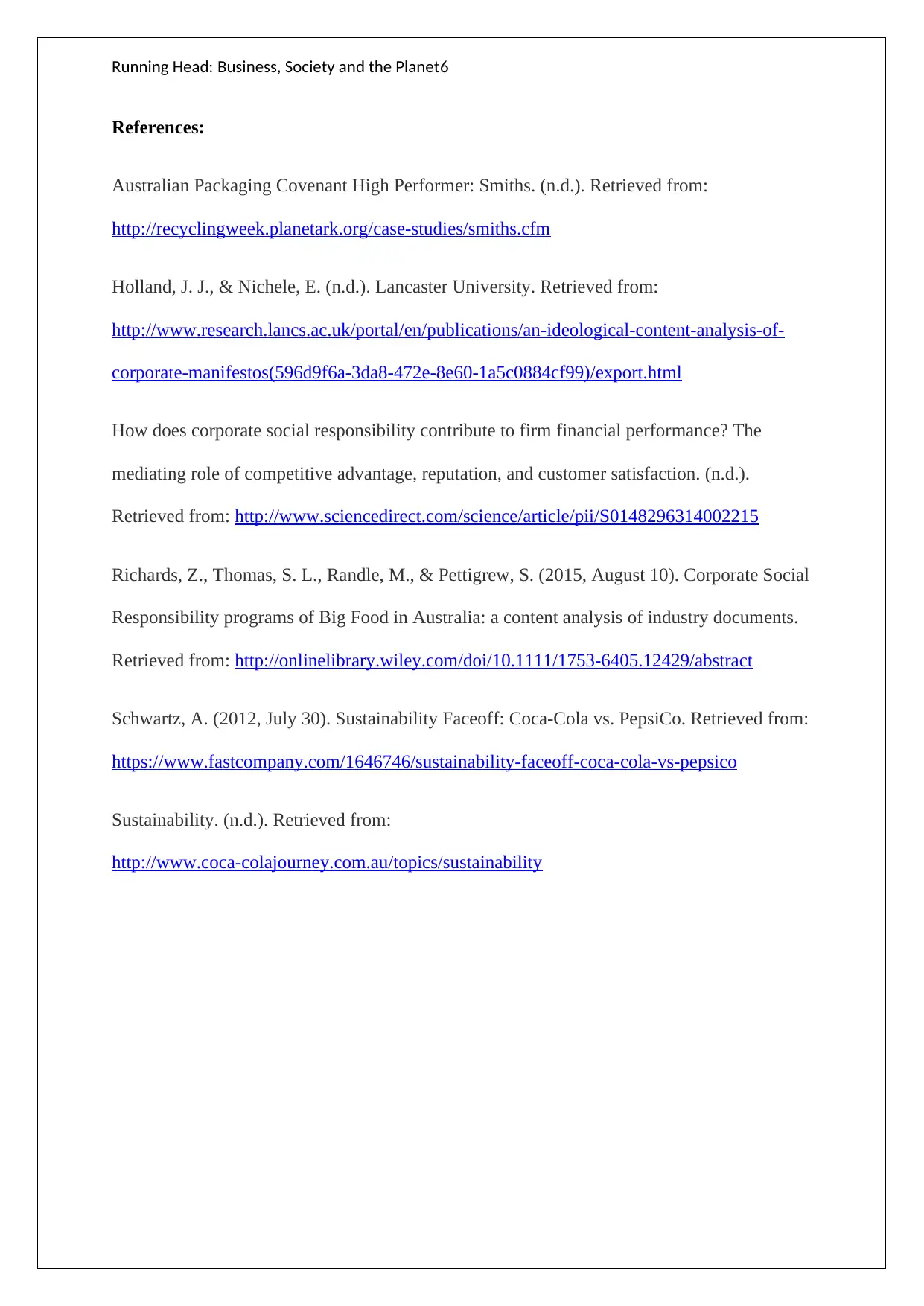
Running Head: Business, Society and the Planet6
References:
Australian Packaging Covenant High Performer: Smiths. (n.d.). Retrieved from:
http://recyclingweek.planetark.org/case-studies/smiths.cfm
Holland, J. J., & Nichele, E. (n.d.). Lancaster University. Retrieved from:
http://www.research.lancs.ac.uk/portal/en/publications/an-ideological-content-analysis-of-
corporate-manifestos(596d9f6a-3da8-472e-8e60-1a5c0884cf99)/export.html
How does corporate social responsibility contribute to firm financial performance? The
mediating role of competitive advantage, reputation, and customer satisfaction. (n.d.).
Retrieved from: http://www.sciencedirect.com/science/article/pii/S0148296314002215
Richards, Z., Thomas, S. L., Randle, M., & Pettigrew, S. (2015, August 10). Corporate Social
Responsibility programs of Big Food in Australia: a content analysis of industry documents.
Retrieved from: http://onlinelibrary.wiley.com/doi/10.1111/1753-6405.12429/abstract
Schwartz, A. (2012, July 30). Sustainability Faceoff: Coca-Cola vs. PepsiCo. Retrieved from:
https://www.fastcompany.com/1646746/sustainability-faceoff-coca-cola-vs-pepsico
Sustainability. (n.d.). Retrieved from:
http://www.coca-colajourney.com.au/topics/sustainability
References:
Australian Packaging Covenant High Performer: Smiths. (n.d.). Retrieved from:
http://recyclingweek.planetark.org/case-studies/smiths.cfm
Holland, J. J., & Nichele, E. (n.d.). Lancaster University. Retrieved from:
http://www.research.lancs.ac.uk/portal/en/publications/an-ideological-content-analysis-of-
corporate-manifestos(596d9f6a-3da8-472e-8e60-1a5c0884cf99)/export.html
How does corporate social responsibility contribute to firm financial performance? The
mediating role of competitive advantage, reputation, and customer satisfaction. (n.d.).
Retrieved from: http://www.sciencedirect.com/science/article/pii/S0148296314002215
Richards, Z., Thomas, S. L., Randle, M., & Pettigrew, S. (2015, August 10). Corporate Social
Responsibility programs of Big Food in Australia: a content analysis of industry documents.
Retrieved from: http://onlinelibrary.wiley.com/doi/10.1111/1753-6405.12429/abstract
Schwartz, A. (2012, July 30). Sustainability Faceoff: Coca-Cola vs. PepsiCo. Retrieved from:
https://www.fastcompany.com/1646746/sustainability-faceoff-coca-cola-vs-pepsico
Sustainability. (n.d.). Retrieved from:
http://www.coca-colajourney.com.au/topics/sustainability
⊘ This is a preview!⊘
Do you want full access?
Subscribe today to unlock all pages.

Trusted by 1+ million students worldwide
1 out of 6
Related Documents
Your All-in-One AI-Powered Toolkit for Academic Success.
+13062052269
info@desklib.com
Available 24*7 on WhatsApp / Email
![[object Object]](/_next/static/media/star-bottom.7253800d.svg)
Unlock your academic potential
Copyright © 2020–2025 A2Z Services. All Rights Reserved. Developed and managed by ZUCOL.





